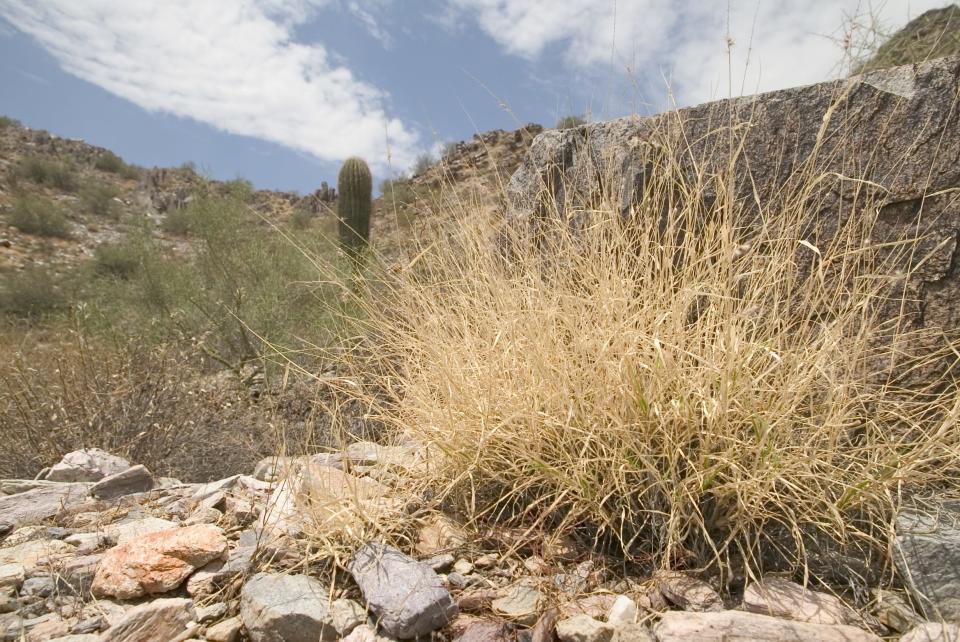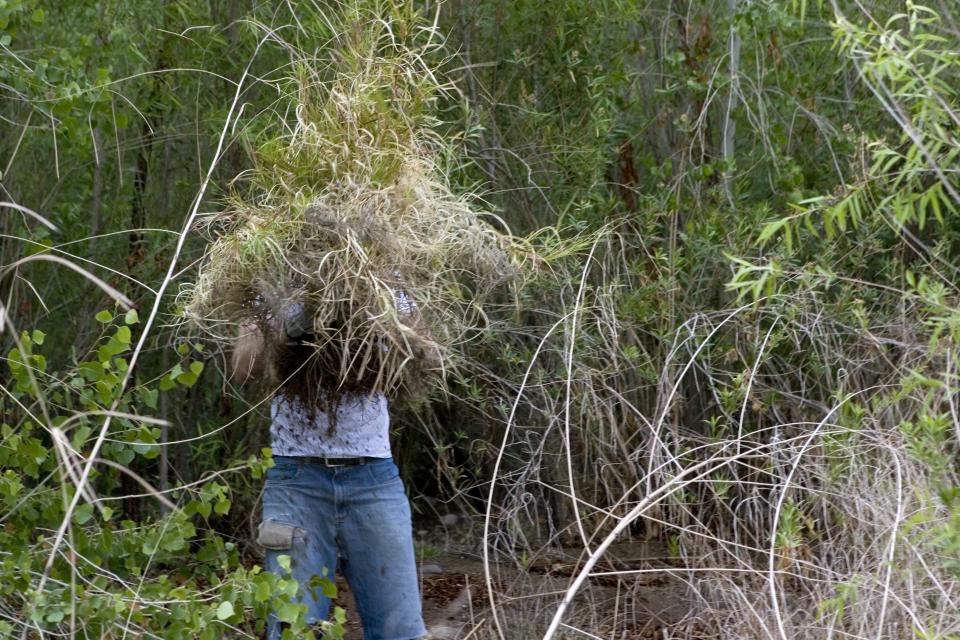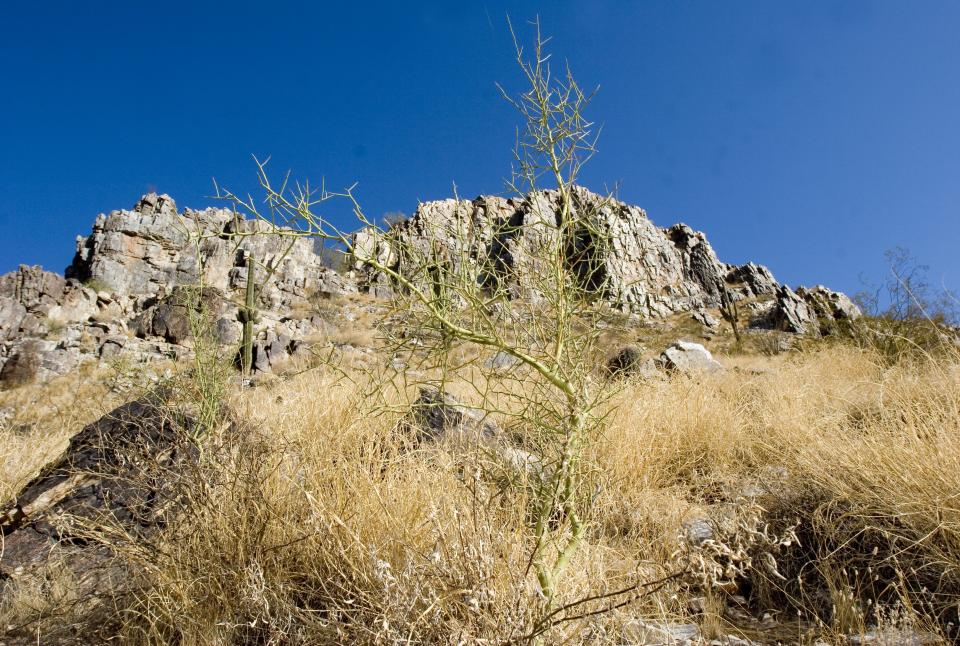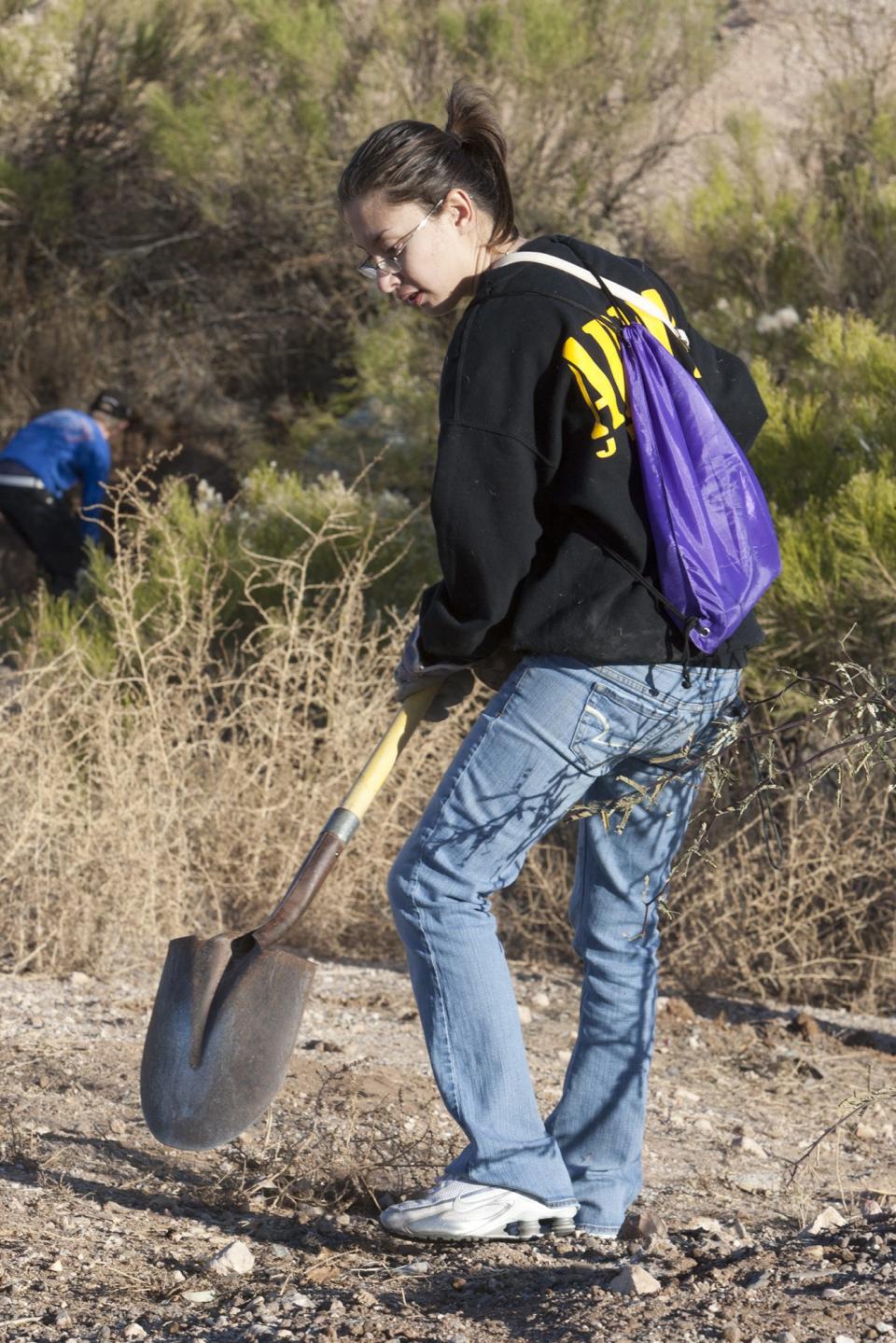How removing invasive buffelgrass from Arizona forests can reduce wildfire threats
TUCSON — In the Santa Catalina Mountains of the Coronado National Forest, buffelgrass has taken over, occupying thousands of acres of wildlands with what can quickly become fuel for wildfires. Land managers are working to remove the invasive grass before wildfires start and burn through saguaro cactuses and other native plants.
Following destructive wildfires like the Bighorn in the Santa Catalinas and the Maui Fire in Hawaii, the National Forest Foundation and the U.S. Forest Service are increasing efforts to remove the non-native grass, which increasingly endangers the Coronado National Forest and neighboring communities.
Buffelgrass is a perennial bunchgrass from South Africa brought to Arizona and 13 other states beginning in the 1930s for cattle forage and to control soil erosion. After spreading rapidly in the 1980s, it has become highly flammable and has played a role in escalating wildfires.

The grass fills the open spaces between native plants, acting as a bridge that can spread flames through desert landscapes where fires would have died out naturally.
“The fire risk is a big deal with buffelgrass right now, especially on the wildland-urban interface,” said John Goraj, the National Forest Foundation’s southern Arizona program senior associate. “We have this landscape that’s not fire-adapted and in the past would have small, infrequent fires that take care of some biomass. But now we’re talking about large-scale fires.”
The Bighorn Fire was sparked by a lightning strike on June 5, 2020, and burned across 119,000 acres. The fire spurred evacuations from homes on the wildland-urban interface that neighbor parts of the forest most at-risk.
The fire began in the Santa Catalina Mountains but burned hotter and farther into the Catalina foothills fueled by buffelgrass. The grass helped spread the flames to lower-elevation saguaro cactuses and native species that would not usually burn.
From Maui to Northwest Christian: Tarasenko twins find success leading their teams
The Maui wildfires made international headlines in August, killing 97 people and destroying 2,000 structures. While the fire was fueled by dry conditions and strong winds, invasive grasses, including buffelgrass, contributed to its swift and uncontrollable spread.
The National Forest Foundation and the U.S. Forest Service are working to map and chemically remove buffelgrass in southern Arizona to prevent future wildfires. Without acres of buffelgrass fueling the flames, officials hope combating wildfires will be easier.

Buffelgrass removal is an 'uphill challenge'
Planners are targeting the south-facing slopes of the Santa Catalina Mountains where buffelgrass grows best. Following winter and summer precipitation, buffelgrass "greens up" typically from its dormant golden color.
Once the grass reaches about 50% green-up, crews can begin chemical treatment. In the spring they have a two to four-week period and in late summer, an eight-week window while the grass is actively growing to complete treatment.
Mechanical removal — digging up buffelgrass — can occur at any point in the year. Although chemical treatments are more effective, mechanically removing buffelgrass by pulling it from the ground can help remove some of the biomass in crowded areas. Mechanical removal can potentially disperse seeds across the landscape.
Invasive strike crews overseen by the foundation and the forest service use glyphosate, also known commercially as Roundup, to kill buffelgrass in predetermined areas of the mountains. According to Goraj, glyphosate is a targeted herbicide and is not mobile in the soil, so it will have limited effects on other plant species.
Arizona environment and climate: Sate projects to receive federal funding
Patches of buffelgrass are typically separate from native vegetation, but Goraj said there is occasionally collateral damage when surrounding plants grow near treated grass.
Officials have treated over 1,000 acres of the Coronado National Forest in the last three years. Although agencies planned to treat over 1,000 acres this summer, lack of rainfall hindered grass growth and limited the window for treatment.
This year, officials treated about 120 acres at Finger Rock and 35 acres at the Cobblestone Unit.
Eliminating buffelgrass is an ongoing battle, and because of its swift growth and active seed dispersal, areas require repeated treatment. Narrow treatment windows and recurrent projects make it difficult to address buffelgrass in the whole region.
“The goal right now is to target the ‘jewels of the Catalina,’ so Finger Rocks, Sabino Canyon, Bear Canyon,” Goraj said. “The best way to do that is repeat treatments every year. It’s really an uphill challenge.”

Buffelgrass 'wipes out' native vegetation
Between the gaps of native desert vegetation, buffelgrass thrives. It grows in dense clumps, acting as a bridge connecting spread-out desert plants.
“There’s lots of open spaces between plants in the desert, that’s how it’s meant to be. Buffelgrass creates connectivity between those plant species,” Goraj said. “That sparse vegetation where there are spaces in between, buffelgrass totally wipes that out.”
Typically open spaces between vegetation act as a buffer during wildfires, extinguishing fires by robbing them of fuel. In areas like the Catalina Mountains with widespread patches of buffelgrass, fires spread more easily.
More homes mean more heat: Can new building codes help save metro Phoenix from disaster?
Not only does this connectivity fuel wildfires, but buffelgrass steals space, nutrients and water from native plants. It grows quickly compared to native vegetation, moving into empty spaces where wildflowers typically grow. Arizona’s arid climate spurs buffelgrass because it flourishes in the sun and resists drought.
“It’s taken about eight million years for the Sonoran Desert to evolve to where it is now,” said Peter Breslin, a plant ecology researcher from the University of Arizona Tumamoc Desert Laboratory. “Buffelgrass has come in and significantly altered ecological interactions of huge portions of the Sonoran Desert in about 40 years.
“It’s very discordant to have this rapid change occurring in an environment that’s evolved very slowly.”

Why landscape restoration is difficult
Buffelgrass has adapted to fire and benefits from repeated burning. While native desert plants are killed or damaged by fires, buffelgrass survives and eventually grows back stronger.
Saguaro cactuses, ponderosa pine, palo verde and other keystone species recover more slowly from destructive fires.
Animals anguish: 2 Sonoran Desert tortoises dead, 1 recovering after brutal summer heat
According to Breslin, multiple factors make restoration projects difficult. Officials would have to prevent buffelgrass from reestablishing itself after fires. If they can thwart buffelgrass from respawning and stealing resources, they would need a multi-species restoration.
Restoration would be unsuccessful if limited to just one species. After replanting multiple native species, experts would have to protect them from potential threats like being eaten by wildlife or stunted by seasonal frosts.
Desert plants often take years to grow and mature. During the first five to 10 years of a saguaro’s life, the cactuses are especially vulnerable and the survival rate is low.
If repeated widespread fires occurred, some areas could transition from a desert ecosystem to a desert savanna grassland, removing keystone species of the Sonoran Desert. While some areas could look vastly different, Breslin says this would not lead to total extinction across southern Arizona.
“A lot of desert-adapted species are very resilient,” Breslin said. “Even if there are range shifts for a lot of species, they tend to adapt. You might have local extinctions that are really visible to people, but over the entire range of a plant like saguaro, it’ll probably be fine.”
Despite the challenges of removing buffelgrass, officials hope to accelerate treatment efforts to protect communities bordering high-risk areas, beloved recreational areas of the Coronado National Forest and the native plants living within it.
Hayleigh Evans covers environmental issues for The Arizona Republic and azcentral. Send tips or questions to hayleigh.evans@arizonarepublic.com.
Environmental coverage on azcentral.com and in The Arizona Republic is supported by a grant from the Nina Mason Pulliam Charitable Trust. Sign up for AZ Climate, our weekly environment newsletter, and follow The Republic environmental reporting team at environment.azcentral.com and @azcenvironment on Facebook, Twitter and Instagram.
You can support environmental journalism in Arizona by subscribing to azcentral.com today.
This article originally appeared on Arizona Republic: As buffelgrass invades Arizona forests, agencies work to remove it

